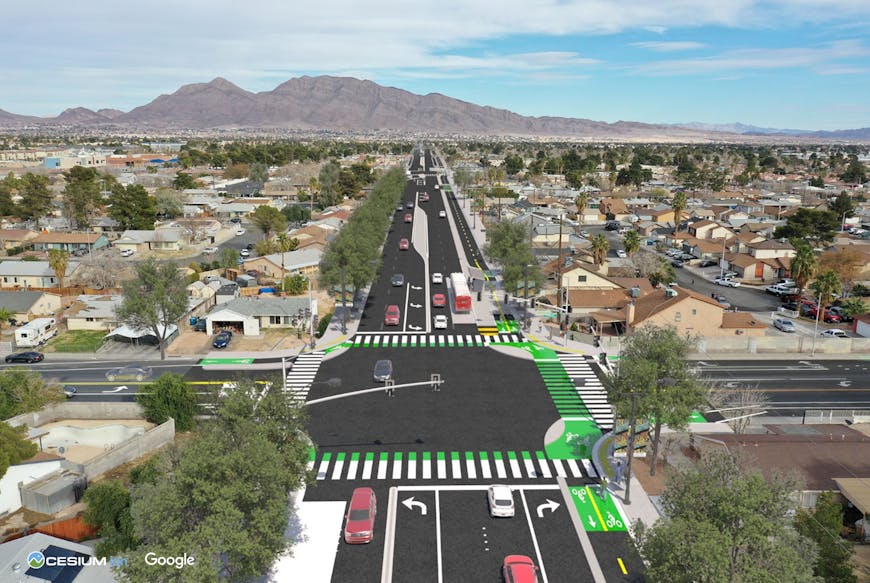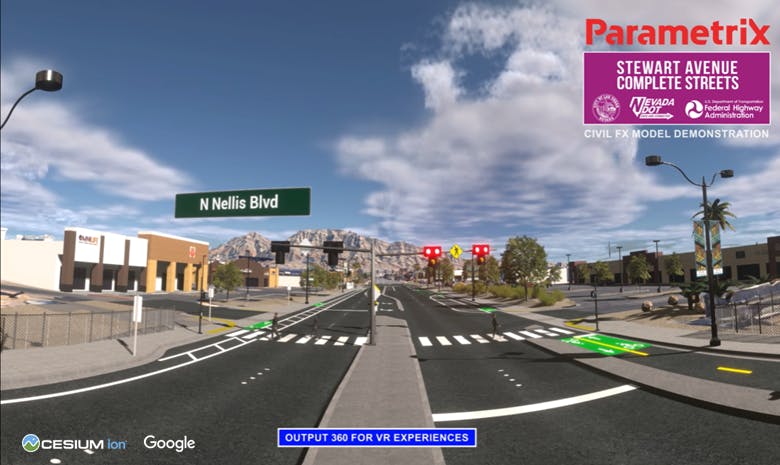Parametrix Engages Communities and Wins Bids with Cesium
"The most brilliant engineering designs, no matter how well crafted, remain unrealized until their vision can be clearly communicated and understood by all stakeholders," said Wayne Sullivan, visualization lead at infrastructure engineering and consulting firm Parametrix. This philosophy drives Parametrix’s Advanced Visualization team: a group of software engineers and 3D artists using Cesium for Unreal, Cesium ion, and Google Photorealistic 3D Tiles to enhance public outreach and help win project bids by making complex designs easier to understand.

High-fidelity, photorealistic renderings of a proposed design helped the City of Las Vegas secure a $25 million grant for the Stewart Avenue Complete Streets project. Courtesy Parametrix.
Founded in Sumner, Washington, in 1969, Parametrix has expanded its services and geographic footprint across the United States. Today, the company provides multidisciplinary services in transportation, water resources, environmental planning, and community building, consistently ranking among top design firms in the regions they serve. In 2020, Parametrix acquired Civil FX, a startup that Sullivan helped build, specializing in interactive visualizations of transportation projects.
Sullivan's Advanced Visualization team has become an integral part of Parametrix. The team's work supports projects across the company, dedicating 75% of their time to visualizing designs for community engagement and 25% to supporting grant and RFP proposals to win new business. Their workflow involves directly importing 3D models, created in applications such as Civil 3D, MicroStation, OpenBridge Modeler, or Revit, into Unreal Engine. The team uses Cesium for Unreal to precisely place these 3D models onto a WGS84 globe. With Cesium ion, they stream Photorealistic 3D Tiles into Unreal Engine to provide rich geospatial context and boost project realism, so stakeholders get a clear picture of changes coming to the communities they care about.
Built on open standards and APIs, Cesium for Unreal combines the 3D geospatial capability of Cesium with the high-fidelity rendering power of Unreal Engine, making smooth rendering and simulation available across industries. Photorealistic 3D Tiles are built on 3D Tiles, the Open Geospatial Consortium (OGC) community standard created by Cesium, to efficiently stream massive amounts of 3D data.
Sullivan and his team began using Cesium in 2023 after learning about it on Reddit and LinkedIn. Today, Sullivan estimates that Cesium for Unreal and Photorealistic 3D Tiles cut about 30% of their team’s project time. “We use that extra time to build better experiences,” said Sullivan.
Parametrix played a crucial role in helping the City of Las Vegas secure a $25 million federal grant to transform a 4.5-mile section of Stewart Avenue. This corridor is a vital route, with more than 35% of all users being pedestrians and cyclists. The City of Las Vegas identified that fragmented sidewalks and a critical lack of shade contribute to an unsafe and uninviting environment for pedestrians and other roadway users, as detailed in their Stewart Avenue Complete Streets Project Fact Sheet.
“This is such an important project to the city and to the community in general,” Nicole Melton, the city engineering project manager, told KLAS news. “And when we do these public works projects that revitalize areas, we can spur economic development.”

VR headsets were used to immerse the public in proposed designs during outreach efforts for the Stewart Avenue Complete Streets project. Courtesy Parametrix.
"Our visualization work was instrumental in communicating the project's vision to help secure its funding, and now we are excited to be involved with its implementation," explained Sullivan. The project is currently in its early design and planning phases, with construction anticipated to begin in 2027. Parametrix continues to leverage Cesium for Unreal and Photorealistic 3D Tiles in their work to gather public feedback. At a recent public meeting, Parametrix streamed the project concept to VR headsets, so attendees could immerse themselves in the proposed design.
Parametrix’s visualization team extended Cesium’s open-source platform to showcase various aesthetic treatments for the Keystone Bridge project in Reno, Nevada. Courtesy Parametrix.
Parametrix also used Cesium for Unreal and Photorealistic 3D Tiles on the Keystone Bridge project in Reno, Nevada, for the Regional Transportation Commission of Washoe. The project required showcasing aesthetic treatments for the bridge. Instead of creating static images to show treatment options, Parametrix developed a dynamic tool on top of Cesium for Unreal, leveraging its open-source foundation. This tool enables instant swapping of different colors of concrete as well as girder and rail colors and types, allowing project stakeholders to examine numerous aesthetic combinations. This interactive approach improves the efficiency of the stakeholder decision-making process, with the detailed model integrating with Photorealistic 3D Tiles for real-world context.
“In the past, we’d have to render so many different aesthetic combinations on a project like this,” Sullivan said. “This tool saves us a lot of rendering time.”
Parametrix’s Advanced Visualization team is committed to pushing the boundaries of project visualization. Their sights are set on leveraging Cesium ion for Gaussian splats production, a feature introduced at the 2025 Cesium Developer Conference. “Post-processing and cleaning up traditional photogrammetry can be time consuming,” explained 3D designer Justin Gould. “I’m looking forward to experimenting with Gaussian splats in Cesium to speed that up and using that data to inform custom geometries,” added Gould.
Get started with a free Cesium ion account to pair your 3D models with accurate geospatial context.